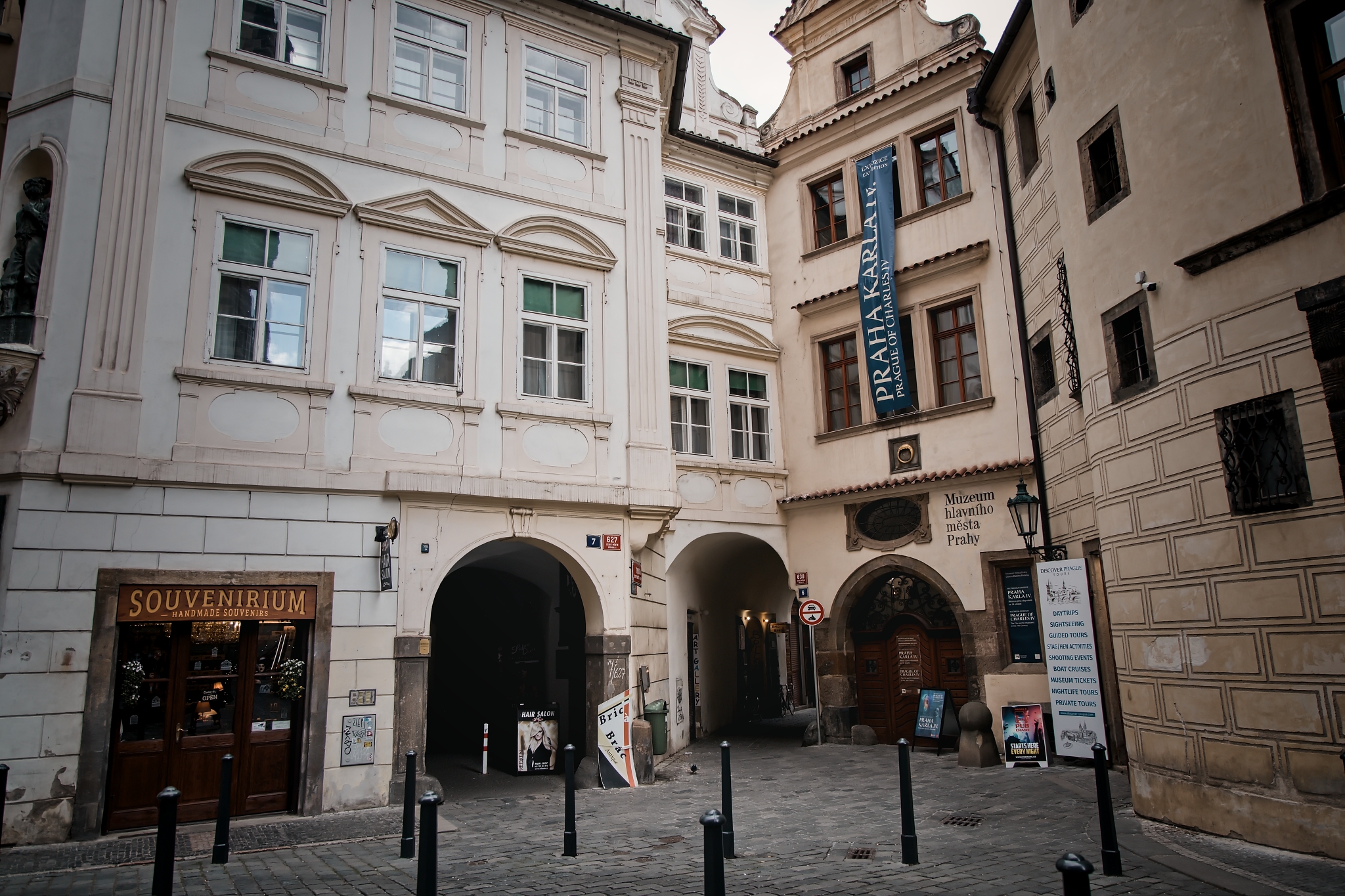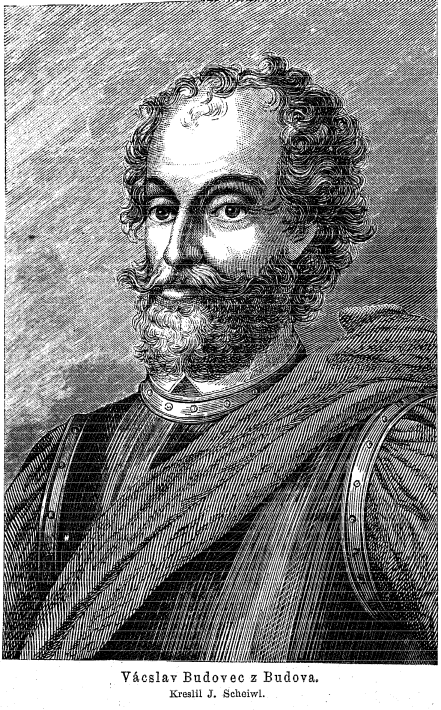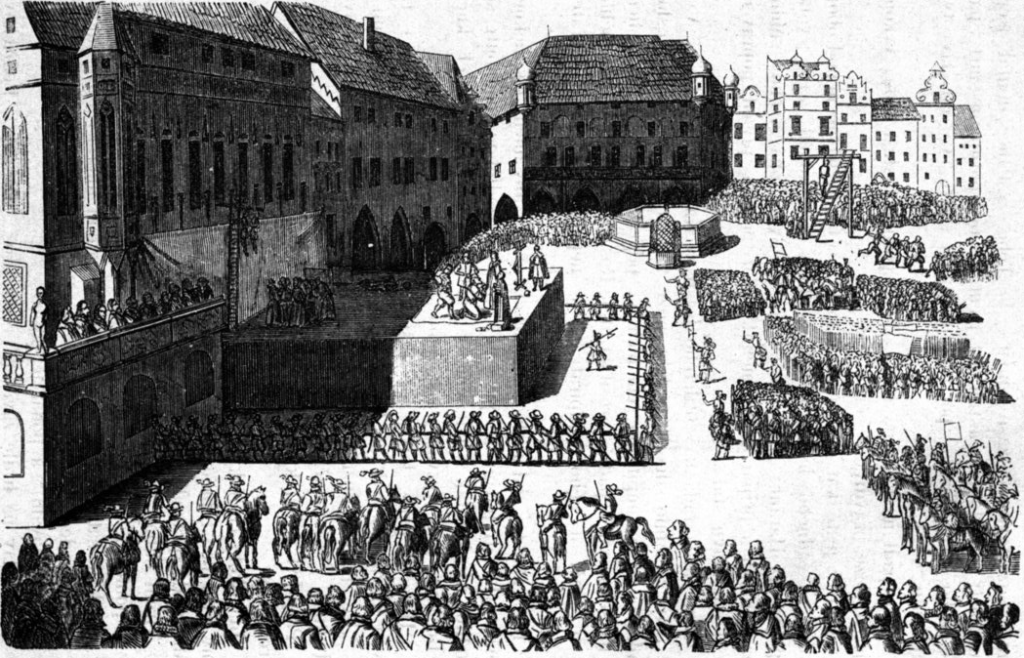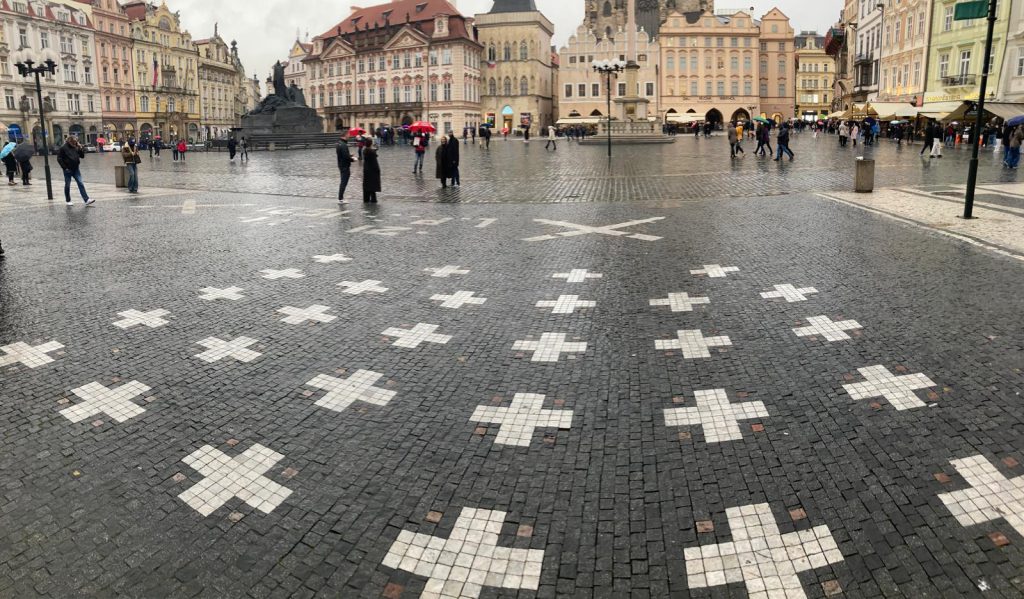
Týnská 7 was originally built during the reign of Charles IV in the 1300s, around the same time when St Vitus’ Cathedral, the Charles Bridge, and the nearby Church of our Lady Before Tyn were under construction. The building was intended as a family home and had several owners before. In 1617, it was purchased by Václav Budovec of Budov. Budovec used this as his town residence whilst his family also owned a castle in Budov, near Karlovy Vary.

The year Budovec purchased the house, 1617, saw the election of a new king of Bohemia, Ferdinand II, who was to succeed his cousin, King Matthias. Matthias had already taken the crown of Bohemia from his brother Rudolf II, whom those of you who’ve taken the Alchemy & Mysteries of Prague Castle tour will have heard a lot about! The problem was though that Matthias was already elderly and childless when he forced Rudolf to give up the throne, and so a new king had to be elected. Whereas Matthias and Rudolf had granted a lot of rights and freedoms to the people of Prague, particularly when it came to religious freedom, Ferdinand was known to be a supporter of the Catholic counter-reformation and so many Protestants in particular were concerned that his rule would bring about a new wave of religious oppression and persecution. The first sign for the Protestants that things were not going well was in 1618 when Ferdinand decided to shut down the construction of some Protestant chapels on the royal lands. Protestants, led by Count Von Thurn, went to Prague Castle to confront Ferdinand’s men, and in the argument that ensued, two of the king’s officials and their secretary were thrown from a third-floor window into the Deer Moat below. They survived the fall, and the secretary was even given the title Baron von Hohenfall by the emperor, which literally means ‘Baron of the Highfall’.
This was, in fact, the start of the Thirty Years War in Europe. The Protestant estates decided that they would not be free under Ferdinand, and so would need to elect their own king. They chose a Protestant prince, Frederick V of Palatine, who was the son-in-law of James I of England, and who became known as the Winter King, after his brief period of rule in Bohemia. Everything finally came to a head on the 8th of November 1620 when supporters of Ferdinand and supporters of Frederick met in battle at a site named Bílá Hora or The White Mountain. The battle only lasted about an hour, however, Ferdinand’s trained soldiers were no match for the hastily gathered Protestant army. In the chaos, Frederick V slipped out of Prague and fled to the Netherlands (where his descendants went on to become the House of Hanover, making him the ancestor of the British Royal Family).
Avoid the crowds at Prague Castle with a mystery tour of alchemy and astrology, taking you to magical locations like New World, Strahov Monastery or Prague Loreto.
3 hour tour | from 26 €
Explore hidden places in Old Town and fill your evening with ghost stories and legends full of death, poverty, misery, or murder.
1,5 hour tour | from 16 €
Discover the history of psychiatry and learn about the development of Prague’s famous psychiatric hospital on its vast grounds.
3 hour tour | from 26 €
Ferdinand arrested 47 leaders of what was known as ‘The Bohemian Revolt’, and in the end 27 of them were to be executed. One of these men was Budovec of Budova, who had been with the Protestant army at the White Mountain.
Budovec had been educated at the Protestant university at Wittenberg and also studied in France and England for twelve years before returning to Bohemia and serving in the court of both Rudolf II and Matthias. He was a scholar and writer, spoke Arabic and Turkish, thanks to a spell working for the ambassador to Constantinople (modern Istanbul), and even translated parts of the Qur’an. He was, however, always a supporter of the religious freedom of the Protestant faith and had been present at the defenestration, though had tried to dissuade Von Thurn from violence.
After the Battle of the White Mountain, he was imprisoned in the White Tower at Prague Castle, and on 21st June 1621, was brought to the Old Town Square where the execution was to take place.

The anniversary of the execution passed a few days ago and wreaths were laid at the site in memory of the victims, but the event is permanently commemorated on the Old Town Square by 27 crosses marked out in the cobbles, one for each of the victims. It was known as ‘The Day of Blood’, and began at 5 am, carrying on until around midday, with a massive crowd of onlookers filling the square.
Budovec reportedly hoped he would be granted a reprieve, right up until the last minute, but just before the time came for his execution he was told:” Václav Budovec, free citizen of Budov, whose arms and head shall be cut off, whose body will be cut in four pieces, is going to be hanged somewhere along the road!”
This rather gruesome punishment was, however, commuted to beheading just before Budovec was taken from his cell and led to the scaffold.
Though attempts were made to persuade Budovec to convert to Catholicism, he stayed resolute and even prayed loudly as he was taken to the scaffold. The executioner Jan Mydlař, whom you can learn about on the Ghost Tour, is said to have remarked that Budovec showed no fear as he went to his death.

Afterward, his head was one of 12 taken by Mydlař to the Old Town Bridge Tower at Charles Bridge, on Ferdinand’s orders. These heads were placed in cages and displayed on the ends of spikes as a warning against any further rebellion. Budovec’s head remained there until November 1631, when after more than ten years of decay and humiliation, the remains were finally taken down and reportedly given a proper burial at the Tyn Church, though none of the remains of any of those executed that day in 1621 have ever been located.
Back home, Budovec’s wife, Anna, continued to care for the building at Týnská 7 until 1628, when she sold it to Lady Maria of Nageroll. The building itself has been remodeled and repaired over the years but still has a memorial to its most famous owner.